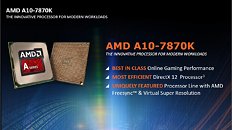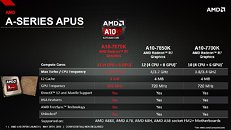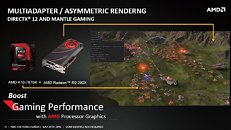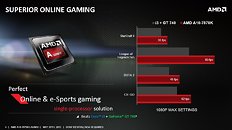Thursday, May 28th 2015

AMD Announces New A-Series Desktop APUs
AMD today introduced the latest addition to its line of desktop A-Series processors, the A10-7870K APU, a refresh to the existing line of processors codenamed "Kaveri". The A10-7870K delivers a best-in-class experience for eSports and online gaming with superior performance, best-in-class efficiency in DirectX 12, and unique features. The new processor also delivers exceptional performance in modern workloads and is designed for the future with Microsoft Windows 10.
The latest iteration of the popular and powerful AMD A-Series APU family provides premium performance and multitasking powered by up to 12 compute cores (4 CPU + 8 GPU). The responsiveness and processing power of the A10-7870K APU enables an immersive user experience on Windows 10 PCs while offering an easy path for PC builders looking to upgrade to discrete-level graphics and faster processing at an afforadable price. The A10-7870K APU is available at e-tail now at a suggested price (SEP) of US $137, and through participating system builders."AMD takes a major step forward today by unveiling the world's most advanced eSports and online gaming processor technology in the A10-7870K APU, giving players the ability to game like a pro without spending like one," said Matt Skynner, corporate VP and general manager, Computing and Graphics Business Unit at AMD. "eSports is one of the fastest-growing pastimes in the world with hundreds of millions of gamers worldwide playing games like StarCraft II, League of Legends, DOTA 2 and Counter-Strike: Global Offensive. With the new A10-7870K APU, gamers can play the most popular online and eSports games right out of the box with features to make that experience even better."
"AMD continues to blaze the trail at the forefront of PC technology," said Ahmed Aziz, CEO and founder of CybertronPC. "With the new AMD A10-7870K processors in a custom gaming CybertronPC, our customers will experience unbelievable gaming performance and the leading edge gaming features of AMD FreeSync and Virtual Screen Resolution -- a marked improvement over existing desktop PC capabilities, and unique to AMD."
Best eSports and Online Gaming Experience
2. Tested in AMD internal labs using AMD A10-7870K Radeon R7, with AMD Radeon R7 Graphics, 2x4096 MBytes of DDR3-1866 RAM, Microsoft Windows 10 Pro Insider Preview,15.200.0.0 and Intel Core i5-4570R CPU @ 2.70GHz with Intel Iris Pro Graphics 5200 graphics, 2x4096 MBytes of DDR3-1600 RAM, 10.18.15.4204. A10-7870K performed 5,167,514 draw calls in DirectX 12 while the Core i5 performed 1,610,377 draw calls in DirectX12.
3. FreeSync is an AMD technology designed to eliminate stuttering and/or tearing in games and videos by locking a display's refresh rate to the framerate of the graphics card. Requires Monitor, AMD Radeon graphics and/or AMD A-Series APU compliant with DisplayPort Adaptive-Sync 1.2 (or newer). AMD Catalyst driver 15.2 Beta (or newer) required. Adaptive refresh rates vary by display; check with your monitor manufacturer for specific capabilities. Only select AMD Radeon GPUs and A-Series APUs supported; see www.amd.com/freesync for full details.
4. AMD Eyefinity technology supports up to four DisplayPort monitors with select AMD A-Series APUs. Supported display quantity, type and resolution vary by APU model and system design; confirm specifications with the system manufacturer before purchase. To enable more than two displays, or multiple displays from a single output, additional hardware such as DisplayPort-ready monitors or DisplayPort 1.2 MST-enabled hubs may be required. A maximum of two active adapters is recommended. See www.amd.com/eyefinityfaq for full details.
5. Based on PCMark Home testing using an AMD A10-7870K with 2x8 GB DDR3-2400, 256GB SSD, Windows 8.1, beta 15.10 drivers which scored 3457 in PCMark 8 Home v2. Intel i3 4370 with 2x8 DDR3-2133, 256GB SSD, Windows 8.1 Driver 4156 which scored 3304 in PCMark 8 Home v2. Core i3 4370 pricing of $151US as of May 7, 2015 at pricewatch.com vs $130US for A10-7870K estimated e-tail pricing as of May 28, 2015. GV-1
The latest iteration of the popular and powerful AMD A-Series APU family provides premium performance and multitasking powered by up to 12 compute cores (4 CPU + 8 GPU). The responsiveness and processing power of the A10-7870K APU enables an immersive user experience on Windows 10 PCs while offering an easy path for PC builders looking to upgrade to discrete-level graphics and faster processing at an afforadable price. The A10-7870K APU is available at e-tail now at a suggested price (SEP) of US $137, and through participating system builders."AMD takes a major step forward today by unveiling the world's most advanced eSports and online gaming processor technology in the A10-7870K APU, giving players the ability to game like a pro without spending like one," said Matt Skynner, corporate VP and general manager, Computing and Graphics Business Unit at AMD. "eSports is one of the fastest-growing pastimes in the world with hundreds of millions of gamers worldwide playing games like StarCraft II, League of Legends, DOTA 2 and Counter-Strike: Global Offensive. With the new A10-7870K APU, gamers can play the most popular online and eSports games right out of the box with features to make that experience even better."
"AMD continues to blaze the trail at the forefront of PC technology," said Ahmed Aziz, CEO and founder of CybertronPC. "With the new AMD A10-7870K processors in a custom gaming CybertronPC, our customers will experience unbelievable gaming performance and the leading edge gaming features of AMD FreeSync and Virtual Screen Resolution -- a marked improvement over existing desktop PC capabilities, and unique to AMD."
Best eSports and Online Gaming Experience
- The AMD A10-7870K represents the best single-processor solution for online and eSports gaming, delivering best-in-class gaming performance -- up to 48 percent higher frame rates in the most popular online games vs. higher priced solutions made up of a CPU and GPU1 -- and more than 3x greater efficiency in DirectX 12 than competing solutions.2
- Gamers can enjoy 1080p gaming on some of the world's most popular games with the settings cranked up, and benefit from unique features only available on AMD A-Series processors to improve the gaming experience. Unique features include Virtual Screen Resolution (VSR) for improved image quality when gaming at lower resolutions, and AMD FreeSync for effortlessly smooth gameplay on FreeSync-compatible displays, bringing the high-end gaming PC experience to the mainstream PC.3
- Be ready for the future with support for multi-threaded APIs including DirectX 12, Vulkan and Mantle that enable advanced gaming technologies to improve performance and visual fidelity, including asymmetric rendering pairing with an AMD Radeon R7 or R9 GPU to support DirectX 12 multi-adapter and multi-engine features.
- AMD Radeon Graphics Core Next (GCN) Architecture is designed to push the boundaries of gaming, providing eSports gamers with higher resolutions and outstanding image quality for an improved visual experience.
- Experience-enhancing features such as AMD Quick Stream and AMD Eyefinity4 combine to deliver more realism and greater fields of view in supported games.
- The AMD A10-7870K APU features 12 compute cores (4 CPU + 8 GPU)*, up to 4.1 GHz CPU clock and 95W TDP for exceptional performance on today's modern workloads, and up to 5 percent faster system performance versus a competitive processor.5
- Enjoy a premium Windows 10 experience with the AMD A10-7870K APU. The new processor is designed to deliver a phenomenal Windows 10 experience enabling the latest Windows 10 features.
- Designed to push not only the boundaries of DirectX 11 and DirectX 12 gaming, the Graphics Core Next (GCN) Architecture is also specifically engineered for general computing and GPU-aware programming languages like C++ AMP and OpenCL 2.0.
- The A10-7870K supports Heterogeneous System Architecture (HSA) features hUMA and hQ which allow the CPU and GPU to work together in supported applications by quickly dividing and directing the right tasks toward the appropriate cores for new levels of performance and efficiency in consumer and commercial PCs.
- The AMD A10-7870K APU is supported by the existing AMD socket FM2+ motherboard ecosystem making it simple to upgrade to the new processor.
- Supports latest PCI Express 3.0 Graphics Cards to enable performance gaming at Ultra HD resolutions.
2. Tested in AMD internal labs using AMD A10-7870K Radeon R7, with AMD Radeon R7 Graphics, 2x4096 MBytes of DDR3-1866 RAM, Microsoft Windows 10 Pro Insider Preview,15.200.0.0 and Intel Core i5-4570R CPU @ 2.70GHz with Intel Iris Pro Graphics 5200 graphics, 2x4096 MBytes of DDR3-1600 RAM, 10.18.15.4204. A10-7870K performed 5,167,514 draw calls in DirectX 12 while the Core i5 performed 1,610,377 draw calls in DirectX12.
3. FreeSync is an AMD technology designed to eliminate stuttering and/or tearing in games and videos by locking a display's refresh rate to the framerate of the graphics card. Requires Monitor, AMD Radeon graphics and/or AMD A-Series APU compliant with DisplayPort Adaptive-Sync 1.2 (or newer). AMD Catalyst driver 15.2 Beta (or newer) required. Adaptive refresh rates vary by display; check with your monitor manufacturer for specific capabilities. Only select AMD Radeon GPUs and A-Series APUs supported; see www.amd.com/freesync for full details.
4. AMD Eyefinity technology supports up to four DisplayPort monitors with select AMD A-Series APUs. Supported display quantity, type and resolution vary by APU model and system design; confirm specifications with the system manufacturer before purchase. To enable more than two displays, or multiple displays from a single output, additional hardware such as DisplayPort-ready monitors or DisplayPort 1.2 MST-enabled hubs may be required. A maximum of two active adapters is recommended. See www.amd.com/eyefinityfaq for full details.
5. Based on PCMark Home testing using an AMD A10-7870K with 2x8 GB DDR3-2400, 256GB SSD, Windows 8.1, beta 15.10 drivers which scored 3457 in PCMark 8 Home v2. Intel i3 4370 with 2x8 DDR3-2133, 256GB SSD, Windows 8.1 Driver 4156 which scored 3304 in PCMark 8 Home v2. Core i3 4370 pricing of $151US as of May 7, 2015 at pricewatch.com vs $130US for A10-7870K estimated e-tail pricing as of May 28, 2015. GV-1




28 Comments on AMD Announces New A-Series Desktop APUs
In that context of APU's I agree, you can't fit 750 in there. I didn't really take into account where APU's are most often used. If we look just a bit broader though, in my opinion you can fit that 750.
I am with you 100% if we start talking about mini ITX mobos and cases. There, probably anything else than an APU could also make sense, in some cases, more sense. But APUs can give you an all around system with good enough GPU power for light gaming in very compact dimensions that you can't have from Intel setups, except if you go for more expensive solutions that use Iris graphics or probably integrate a mobile gpu in them, usually an Nvidia one.
As for the Zotac ZBOX PI320, it uses an Atom chip. It offers everything except performance to do anything else than reading mails and watching a movie. I was talking about something with the size of that Zotac I posted or an NUC. Of course there are so many form factors today, that you can't be sure about that the other means. Smaller systems do exist and they make those Zotacs look like big boxes, but they are usually Atom based or ARM based systems.